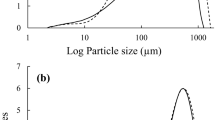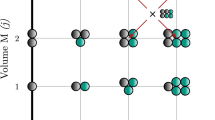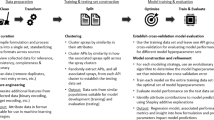Abstract
Solid particle agglomeration is a prevalent phenomenon in various processes across the chemical, food, and pharmaceutical industries. In pharmaceutical manufacturing, agglomeration is both desired in unit operations like wet granulation and undesired in unit operations such as agitated filter drying of highly potent active pharmaceutical ingredients (API). Agglomeration needs to be controlled for optimal physical properties of the API powder. Even after decades of work in the field, there is still very limited understanding of how to quantify, predict, and control the extent of agglomeration, owing to the complex interaction between the solvent and the solid particles and stochasticity imparted by mixing. Furthermore, a large size of industrial scale particulate process systems makes it computationally intractable. To overcome these challenges, we present a novel theory and computational methodology to predict the agglomeration extent by coupling the experimental measurements of agglomeration risk zone or “sticky zone” with discrete element method. The proposed model shows good agreement with experiments. Further, a machine learning model was built to predict agglomeration extent as a function of input variables, such as material properties and processing conditions, in order to build a digital twin of the unit operation. While the focus of the present study is the agglomeration of particles during industrial drying processes, the proposed methodology can be readily applied to numerous other particulate processes where agglomeration is either desired or undesired.







Similar content being viewed by others
References
Pietsch W. An interdisciplinary approach to size enlargement by agglomeration. Powder Technol. 2003;130(1–3):8–13.
Cuq B, Mandato S, Jeantet R, Saleh K, Ruiz T. Agglomeration/granulation in food powder production. In: Handbook of Food Powders: Processes and Properties: Elsevier Inc.; 2013. p. 150–77.
Flore K, Schoenherr M, Feise H. Aspects of granulation in the chemical industry. Powder Technol. 2009;189(2):327–31.
Palzer S. Agglomeration of pharmaceutical, detergent, chemical and food powders - similarities and differences of materials and processes. Powder Technol. 2011;206(1–2):2–17.
Vervaet C, Remon JP. Continuous granulation in the pharmaceutical industry. In: Chemical Engineering Science: Pergamon; 2005. p. 3949–57.
Faure A, York P. Rowe RC. Process control and scale-up of pharmaceutical wet granulation processes: a review. E J Pharm Biopharm Elsevier. 2001;52:269–77.
Santl M, Ilic I, Vrecer F, Baumgartner S. A compressibility and compactibility study of real tableting mixtures: the effect of granule particle size. Acta Pharm [Internet]. 2012 [cited 2020 Jul 28];62(3):325–40. Available from: https://content.sciendo.com/view/journals/acph/62/3/article-p325.xml.
Kawashima Y, Imai M, Takeuchi H, Yamamoto H, Kamiya K, Hino T. Improved flowability and compactibility of spherically agglomerated crystals of ascorbic acid for direct tableting designed by spherical crystallization process. In: Powder Technology: Elsevier; 2003. p. 283–9.
Papageorgiou CD, Langston M, Hicks F, Am Ende D, Martin E, Rothstein S, et al. Development of screening methodology for the assessment of the agglomeration potential of APIs. Org Process Res Dev. 2016;20(8):1500–8.
Murru M, Giorgio G, Montomoli S, Ricard F, Stepanek F. Model-based scale-up of vacuum contact drying of pharmaceutical compounds. Chem Eng Sci. 2011;66(21):5045–54.
Schlünder EU, Mollekopf N. Vacuum contact drying of free flowing mechanically agitated particulate material. Chem Eng Process. 1984;18(2):93–111.
Kemp IC, Oakley DE. Modelling of particulate drying in theory and practice. Dry Technol. 2002;20(9):1699–750.
Birch M, Marziano I. Understanding and avoidance of agglomeration during drying processes: a case study. Org Process Res Dev. 2013;17(10):1359–66.
Conder EW, Cosbie AS, Gaertner J, Hicks W, Huggins S, MacLeod CS, et al. The pharmaceutical drying unit operation: an industry perspective on advancing the science and development approach for scale-up and technology transfer. Org Process Res Dev. 2017;21(3):420–9.
Kim S, Lotz B, Lindrud M, Girard K, Moore T, Nagarajan K, et al. Control of the particle properties of a drug substance by crystallization engineering and the effect on drug product formulation. Org Process Res Dev. 2005;9(6):894–901.
Zhang S, Lamberto DJ. Development of new laboratory tools for assessment of granulation behavior during bulk active pharmaceutical ingredient drying. J Pharm Sci. 2014;103(1):152–60.
Sahni EK, Bogner RH, Chaudhuri B. Systematic investigation of parameters affecting the performance of an agitated filter-dryer. J Pharm Sci. 2013;102(7):2198–213.
Sahni EK, Chaudhuri B. Contact drying: a review of experimental and mechanistic modeling approaches. Int J Pharm. 2012;434:334–48.
Hamilton P, Littlejohn D, Nordon A, Sefcik J, Slavin P, Andrews J, et al. Investigation of factors affecting isolation of needle-shaped particles in a vacuum-agitated filter drier through non-invasive measurements by Raman spectrometry. Chem Eng Sci. 2013;101:878–85.
Am Ende D, Birch M, Brenek SJ, Maloney MT. Development and application of laboratory tools to predict particle properties upon scale-up in agitated filter-dryers. Org Process Res Dev [Internet]. 2013 [cited 2020 Aug 2];17(10):1345–58. Available from: https://pubs.acs.org/sharingguidelines.
Remy B, Kightlinger W, Saurer EM, Domagalski N, Glasser BJ. Scale-up of agitated drying: effect of shear stress and hydrostatic pressure on active pharmaceutical ingredient powder properties. AICHE J. 2015;61(2):407–18.
Tamrakar A, Gunadi A, Piccione PM, Ramachandran R. Dynamic agglomeration profiling during the drying phase in an agitated filter dyer: parametric investigation and regime map studies. Powder Technol [Internet]. 2016 [cited 2020 Aug 1];303:109–23. Available from: https://doi.org/10.1016/j.powtec.2016.09.012
Lim HL, Hapgood KP, Haig B. Understanding and preventing agglomeration in a filter drying process. Powder Technol. 2016;300:146–56.
Iveson SM, Litster JD, Hapgood K, Ennis BJ. Nucleation, growth and breakage phenomena in agitated wet granulation processes: a review. Powder Technol. 2001;117(1–2):3–39.
Shin YJ, Ho R, Sheikh AY, Kumar P, Sinha K, Nere NK, et al. Toward a holistic approach to assess particle agglomeration: impact of intrinsic materials properties. Ind Eng Chem Res. 2019;58(24):10394–401.
Adamson J, Faiber N, Gottlieb A, Hamsmith L, Hicks F, Mitchell C, et al. Development of suitable plant-scale drying conditions that prevent api agglomeration and dehydration. Org Process Res Dev [Internet]. 2016 [cited 2020 Jul 28];20(1):51–8. Available from: https://pubs.acs.org/sharingguidelines
Fries L, Antonyuk S, Heinrich S, Dopfer D, Palzer S. Collision dynamics in fluidised bed granulators: a DEM-CFD study. Chem Eng Sci [Internet]. 2013 [cited 2020 Aug 2];86:108–23. Available from: https://www.sciencedirect.com/science/article/pii/S0009250912003752.
Dosta M, Antonyuk S, Heinrich S. Multiscale simulation of the fluidized bed granulation process. Chem Eng Technol. 2012;35(8):1373–80.
Jajcevic D, Siegmann E, Radeke C, Khinast JG. Large-scale CFD-DEM simulations of fluidized granular systems. Chem Eng Sci. 2013;98:298–310.
Ding J, Gidaspow D. A bubbling fluidization model using kinetic theory of granular flow. AIChE J [Internet]. 1990 [cited 2020 Aug 2];36(4):523–38. Available from: https://aiche.onlinelibrary.wiley.com/doi/full/10.1002/aic.690360404.
Cryer SA. Modeling agglomeration processes in fluid-bed granulation. AIChE J [Internet]. 1999 [cited 2020 Aug 2];45(10):2069–78. Available from: http://doi.wiley.com/10.1002/aic.690451005.
Tan HS, Goldschmidt MJV, Boerefijn R, Hounslow MJ, Salman AD, Kuipers JAM. Building population balance model for fluidized bed melt granulation: Lessons from kinetic theory of granular flow. Powder Technol. 2004;142(2–3):103–9.
Heinrich S, Peglow M, Ihlow M, Henneberg M, Mörl L. Analysis of the start-up process in continuous fluidized bed spray granulation by population balance modelling. Chem Eng Sci. 2002;57(20):4369–90.
Vreman AW, van Lare CE, Hounslow MJ. A basic population balance model for fluid bed spray granulation. Chem Eng Sci. 2009;64(21):4389–98.
Muddu SV, Tamrakar A, Pandey P, Ramachandran R. Model development and validation of fluid bed wet granulation with dry binder addition using a population balance model methodology. Processes. 2018;6(9).
Freireich B, Litster J, Wassgren C. Using the discrete element method to predict collision-scale behavior: a sensitivity analysis. Chem Eng Sci. 2009;64(15):3407–16.
Gantt JA, Gatzke EP. High-shear granulation modeling using a discrete element simulation approach. In: Powder Technology; 2005. p. 195–212.
Gantt JA, Cameron IT, Litster JD, Gatzke EP. Determination of coalescence kernels for high-shear granulation using DEM simulations. Powder Technol. 2006;170(2):53–63.
Sen M, Barrasso D, Singh R, Ramachandran R. A multi-scale hybrid CFD-DEM-PBM description of a fluid-bed granulation process. Processes. 2014;2(1):89–111.
Tamrakar A, Ramachandran R. CFD–DEM–PBM coupled model development and validation of a 3D top-spray fluidized bed wet granulation process. Comput Chem Eng. 2019;125:249–70.
Sarkar A, Shoemaker B, Doshi P, Ende MT, Jajcevic D, Böhling P, et al. Multiscale modeling of a pharmaceutical fluid bed coating process using Cfd/Dem and population balance models to predict coating uniformity. In: Chemical Engineering in the Pharmaceutical Industry [Internet]. Hoboken, NJ, USA: John Wiley & Sons, Inc.; 2019 [cited 2020 Aug 2]. p. 419–50. Available from: http://doi.wiley.com/10.1002/9781119600800.ch67
Abramov YA. Understanding the risk of agglomeration of polar pharmaceutical crystals. Cryst Growth Des. 2017;17(5):2873–80.
Hennigs C, Kockel TK, Langrish TAG. New measurements of the sticky behavior of skim milk powder. Dry Technol. 2001;19(3–4):471–84.
Brockherde F, Vogt L, Li L, Tuckerman ME, Burke K, Müller KR. Bypassing the Kohn-Sham equations with machine learning. Nat Commun. 2017;8(1).
Tracey B, Duraisamy K, Alonso JJ. A machine learning strategy to assist turbulence model development. In: 53rd AIAA Aerospace Sciences Meeting. American Institute of Aeronautics and Astronautics: Reston, Virginia; 2015.
Huynh-Thu VA, Irrthum A, Wehenkel L, Geurts P. Inferring regulatory networks from expression data using tree-based methods. PLoS One. 2010;5(9):e12776.
Grant CE, Bailey TL, Noble WS. FIMO: scanning for occurrences of a given motif. Bioinformatics. 2011;27(7):1017–8.
Cundall PA, Strack ODL. A discrete numerical model for granular assemblies. Geotechnique. 1979;29(1):47–65.
Mindlin RD. Compliance of elastic bodies in contact. Collect Pap Raymond D Mindlin Vol I. 1989;71(259):197–206.
Zhang HP, Makse HA. Jamming transition in emulsions and granular materials. Phys Rev E - Stat Nonlinear, Soft Matter Phys. 2005;72(1):011301.
Ai J, Chen JF, Rotter JM, Ooi JY. Assessment of rolling resistance models in discrete element simulations. Powder Technol. 2011;206(3):269–82.
Johnson KL, Kendall K, Roberts AD. Surface energy and the contact of elastic solids. Proc R Soc London A Math Phys Sci. 1971;324(1558):301–13.
Kloss C, Goniva C, Hager A, Amberger S, Pirker S. Models, algorithms and validation for opensource DEM and CFD-DEM. Prog Comput Fluid Dyn. 2012;12(2–3):140–52.
Li Y, Xu Y, Thornton C. A comparison of discrete element simulations and experiments for “sandpiles” composed of spherical particles. Powder Technol. 2005;160(3):219–28.
Silbert LE, Ertaş D, Grest GS, Halsey TC, Levine D, Plimpton SJ. Granular flow down an inclined plane: Bagnold scaling and rheology. Phys Rev E - Stat Physics, Plasmas, Fluids, Relat Interdiscip Top [Internet]. 2001 25;64(5):14. Available from: https://link.aps.org/doi/10.1103/PhysRevE.64.051302.
Murphy E, Subramaniam S. Binary collision outcomes for inelastic soft-sphere models with cohesion. Powder Technol. 2017;305:462–76.
Hærvig J, Kleinhans U, Wieland C, Spliethoff H, Jensen AL, Sørensen K, et al. On the adhesive JKR contact and rolling models for reduced particle stiffness discrete element simulations. Powder Technol [Internet]. 2017;319:472–82. Available from: http://www.sciencedirect.com/science/article/pii/S0032591017305430.
Kumar P, Sinha K, Nere NK, Shin Y, Ho R, Mlinar LB, et al. A machine learning framework for computationally expensive transient models. Sci Rep [Internet]. 2020 [cited 2020 Jul 28];10(1):11492. Available from: https://www.nature.com/articles/s41598-020-67546-w.
Ergun S. Fluid flow through packed columns. Chem Eng Prog. 1952;48:89–94.
Wen CY, Yu YH. Mechanics of fluidization. Chem Eng Progress, Symp Ser [Internet]. 1966;62(1):100–11.
Gidaspow D. Hydrodynamics of fiuidizatlon and heat transfer: supercomputer modeling. Appl Mech Rev [Internet]. 1986;39(1):1–23. Available from: https://doi.org/10.1115/1.3143702.
Tenneti S, Garg R, Subramaniam S. Drag law for monodisperse gas-solid systems using particle-resolved direct numerical simulation of flow past fixed assemblies of spheres. Int J Multiph Flow [Internet]. 2011;37(9):1072–92 Available from: http://www.sciencedirect.com/science/article/pii/S0301932211001170.
Dogon D, Golombok M. Particle agglomeration in sheared fluids. J Pet Explor Prod Technol. 2015;5(1):91–8.
Maindonald J. Pattern recognition and machine learning [Internet]. Vol. 17, Journal of Statistical Software. 2007 [cited 2020 Jul 29]. Available from: https://cds.cern.ch/record/998831.
Zou H, Hastie T. Regularization and variable selection via the elastic net. J R Stat Soc Ser B Stat Methodol. 2005;67(2):301–20.
Jap D, Stöttinger M, Bhasin S. Support vector regression. Neural Inf Process – Lett Rev. 2015;11(10):1–8.
Geladi P, Kowalski BR. Partial least-squares regression: a tutorial. Anal Chim Acta. 1986;185(C):1–17.
Svetnik V, Liaw A, Tong C, Christopher Culberson J, Sheridan RP, Feuston BP. Random forest: a classification and regression tool for compound classification and QSAR modeling. J Chem Inf Comput Sci. 2003;43(6):1947–58.
Pedregosa F, Grisel O, Weiss R, Passos A, Brucher M, Varoquax G, et al. Scikit-learn: machine learning in python. J Mach Learn Res. 2011;12(Oct):2825–30.
Walton OR, Braun RL. Viscosity, granular-temperature, and stress calculations for shearing assemblies of inelastic, frictional disks. J Rheol (N Y N Y) [Internet]. 1986;30(5):949–80. Available from: https://doi.org/10.1122/1.549893.
Coetzee CJ. Review: Calibration of the discrete element method. Powder Technol [Internet]. 2017;310:104–42 Available from: http://www.sciencedirect.com/science/article/pii/S0032591017300268.
Bin YS, Ha E, Kim M, Jeong SH, Hwang SJ, Choi DH. Application of the discrete element method for manufacturing process simulation in the pharmaceutical industry. Pharmaceutics. 2019;11.
Am Ende D, Birch M, Brenek SJ, Maloney MT. Development and application of laboratory tools to predict particle properties upon scale-up in agitated filter-dryers. Org Process Res Dev. 2013;17(10):1345–58.
Acknowledgements
The authors would like to thank Aashish Goyal and Mothivel Mummudi from Tridiagonal Solutions for DEM support and Samrat Mukherjee, Ahmad Sheikh, and Onkar Manjrekar from Process Research and Development organization for their support.
Author information
Authors and Affiliations
Corresponding author
Additional information
Guest Editors: Alexander Russell and Maxx Capece
Publisher’s Note
Springer Nature remains neutral with regard to jurisdictional claims in published maps and institutional affiliations.
Rights and permissions
About this article
Cite this article
Sinha, K., Murphy, E., Kumar, P. et al. A Novel Computational Approach Coupled with Machine Learning to Predict the Extent of Agglomeration in Particulate Processes. AAPS PharmSciTech 23, 18 (2022). https://doi.org/10.1208/s12249-021-02083-x
Received:
Accepted:
Published:
DOI: https://doi.org/10.1208/s12249-021-02083-x




